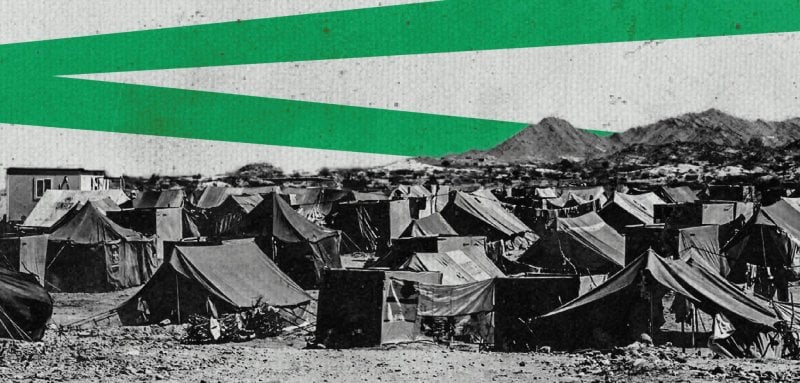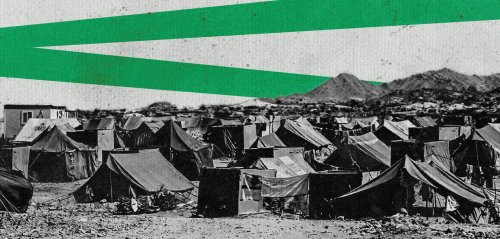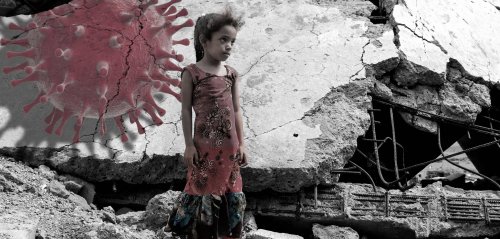Abdullah al-Ghanmi, 52, spent the last seven years of his life traveling with his family members from one displaced camp to another. Fleeing the flames of war that haunted them wherever they went,they only carry with them what remains of their belongings which only consist of clothes and blankets to protect them from the cold.
He points with his hand to his tent located at the end of the al-Naqaa camp for displaced people, located in a desert region east of Marib Governorate, and tells Raseef22, "We arrived here on foot in late 2021, and before that we were in the Dhana camp in al-Rawda area, southwest of Marib, but the battles followed us there, as the Houthi group targeted the camp."

He points his hand toward the sky, then places it over his head and says, "The shelling was falling on our heads, and I don't know how we survived death this time either." He also points out that they were subjected to other similar situations, in which they were trapped in areas where Houthi forces entered into a fight with the internationally-recognized government, that included various types of weapons that do not distinguish between the military and civilians.
A statement by the Yemeni Prime Minister and the Internally Displaced Persons (IDPs) Management confirms al-Ghanmi's account of the events of their escape from said camp. The statement also noted that 17,220 families were displaced from that camp in December 2021, many of whom headed to al-Naqaa desert.
Battle after battle, the area saw a large number of displaced people flee towards Marib governorate in eastern Yemen, until their numbers according to the IDP Management reached 2,222,000 displaced persons who flocked from 14 Yemeni governorates. They were distributed mostly in the housing they either bought or rented, while some stayed with relatives, and 269,397 of them lived in 198 camps set up for them across various parts of the governorate.
These camps are run by a government unit under the Yemeni Prime Minister's office called the Executive Unit for IDP Camps Management. Its task is to coordinate the interventions of humanitarian organizations according to the needs of each camp, and it has opened branches in the governorates to facilitate their work, according to the Director-General of the Executive Unit for Internally Displaced Persons (IDPs) in Marib, Saif Muthanna.
Muthanna confirms to Raseef22 that displaced Yemenis in Marib, especially those in the desert, face great difficulties that his institution is unable to manage, due to the scarcity of intervention by relief organizations, as a result of the weak funding they are receiving from the funding agencies.
One of these difficulties is the fact that the displacement camps were supposed to be a temporary shelter for the displaced, but have now become a semi-permanent one due to more than 7 years passing since their establishment. He adds with regret evident on his face, "They are now just worn out tents," pointing to the reality of the camps in the absence of support.

He further alludes to the poor and non-existent services in many camps, such as electricity, water, health, and education, despite the efforts he says are being made to provide what can be supplied in order to alleviate the suffering of the displaced.
Muthanna explains that humanitarian aid and services are provided in the camps located in the center of Marib Governorate, while the camps that have been set up for he displaced in the desert of the governorate lack the most basic services, "and humanitarian interventions by humanitarian partners are very weak there, for example, UNICEF has not provided any projects to support education in those camps that are far from the city center of Marib, and there is not even a single school for children."
He states that he had made requests for the camps’ needs to the organizations he described as partners, but they had not been able to meet those needs due to the lack of funding which he says they are using as an excuse in their responses to his repeated requests.
"We survived bombing and shelling elsewhere, and here we are at risk of dying of starvation and thirst in the desert."
There are 22 camps in the desert east of Marib. They are scattered across the area, with a distance of about 30 kilometers between each camp. They are inhabited, according to the Executive Unit for IDPs in Marib, by 9,000 displaced persons, constituting approximately 1,200 families.
Abdullah al-Ghanmi and his wife, along with their eight children, are among these displaced persons, in a desert area they see has been forgotten, and where many say, "We survived bombing and shelling everywhere else, and here we are at risk of dying of starvation and thirst in the desert."
Not only that, but there is also a long list of hardships they face there, such as sandstorms, the harsh summer heat, and the extreme cold in the winter. These harsh conditions not only impact the health of the individual there, but also their tents, which have mostly become "worn out", according to them complain.
A lack of health services
The list of needs of the displaced in the camps of Marib desert is long, but water tops the list. They travel long distances on foot to get water, and those who have cars bring it from far away locations.
Some go on foot to get drinking water from the nearest area, filling small bottles that suffice their daily needs. The common aspect of the water in those areas is that it comes from wells, and it is characterized by high levels of salinity.
A displaced woman from al-Naqaa, who asked not to be named, says many of the shortcomings can be tolerated and adapted to, but "this can never be done with medicine," pointing to the absence of health services that the displaced there — along with her personally — have paid a heavy price for.
She chokes up as she speaks, then adds in an angry tone, "My son Aref was not destined to live for more than nine months. The cold killed him..." She is silent for a moment and then continues in a sad voice, "He suffered from diarrhea and vomiting and had a high fever. I took him to the hospital on foot, because I didn't have the money to go by transportation."
The woman walked six kilometers until she reached a hospital called "Kara General Hospital", where she stayed with her little boy for three days, but he eventually died from hypothermia according to the diagnosis of the doctors. A year has passed since then, but the grief still haunts her and she is fearful that her other children will suffer the same fate.
According to a report issued by the Unit for Internally Displaced Persons, three children died last winter, and 12,602 displaced persons in desert camps were afflicted by various health problems caused by the extreme cold that swept through the desert area, in the absence of adequate shelter supplies.
Not a single school is available in the 22 camps within the Marib desert, home to around 9,000 people. Children there have been without systematic education for about eight years.
Fatima Salem, director of reproductive health at the Marib Governorate health office, warned of an increase in gynecological diseases in the camps for the displaced, as 731 abortions and 114 cases of women suffering from diseases associated wut preganancy have been recorded, in addition to "13 cases of puerperal fever and 101 cases of preeclampsia (pregnancy poisoning)" since last June.
All of these cases, according to Fatima, are due to "the unsuitable living conditions in the camps and the absence of proper and timely health services."
Ahmad al-Abadi, deputy director of the Ma’rib health office, acknowledges that IDP camps lack clinics and health services, despite "the high prevalence of infectious diseases among the displaced, such as scabies, malaria, cholera, and smallpox, in addition to coronavirus, which a large number of them have contracted during the pandemic."
Abadi tells Raseef22 that only two of the 198 camps have fixed health units, while the rest of the camps lack them, and patients do not have timely access to medicines.
Abadi also criticized the “timid” role of international organizations in Marib, such as the World Health Organization and the Red Cross, as they "provide only primary health services, which do not live up to the reputation they enjoy globally. They have no role in providing integrated health services and have not established a hospital as they do in other relief areas outside Yemen."
To further clarify, Mohsen al-Humaysi, coordinator of the health and nutrition department of the Marib Executive Unit for Internally Displaced Persons, diagnosed the health service problem in the governorate's camps, telling Raseef22 that 56 of them are without any health services and are in dire need of at least mobile health services, and that mobile health teams visit other camps, once a month or week.
Al-Humaysi said that the efforts of relief organizations focus on food or shelter in general, and rarely provide health assistance, which exposes the displaced to great suffering, as he put it.
Thirty kilometers from al-Naqaa camp, Shadia and her family of six have been living in the Kemb Rodhan camp in the Safari desert since October 2021, after being displaced from the Juba district in southern Marib governorate. She tells Raseef22 that access to health care requires travel to hospitals in the city of Marib, 120 kilometers from the camp, due to the lack of health units in the camp, which is home to 930 displaced families.

It's not just health care that they lack there, according to Shadia. They struggle a great deal to get drinking water and are forced to obtain it from far away.
Children without education
Besides the lack of health services in the IDP camps of Marib, especially those located in the desert, there is also a wide educational gap. There is not a single school available in 22 camps within the Marib desert, home to around 9,000 people. Children there have been without systematic education for about eight years, and there is no tangible role for UNICEF to fill this void.
To minimize the impact of this reality on their children, the displaced have relied on themselves to teach their children to read and write at the very least, through self-initiatives by converting a tent into a temporary school where children are gathered and taught by their parents themselves.

As is the case with regard to health services, the displaced in the center of Marib, specifically in the city, are the ones who receive educational services provided by UNICEF, the IDP Office confirms. The authors of the report were unable to obtain a confirmation from the representative of the organization in Marib.
Yusuf Ahmad, 45, is one of the displaced persons who have been overwhelmed by anxiety over the future of his children, and their inability to keep up with their peers elsewhere in the country, due to the absence of a school in the camp where they could receive an education. So a year ago he sent one of his sons, Alaa, 15, to stay at the house of an old friend nearly 35 kilometers away, so that he could go with his friend’s children to school there and complete his secondary education.
Alaa had previously attended four other schools during four displacement stations his family had been in, starting from Ibb Governorate in the center of the country, all the way to Marib, where they moved between three displacement camps.
"In the camp in the desert, there are no services and no schools, so I had to take Alaa to live in the house of a friend of mine in the valley, where he completed his second year of education, and he has only one year left to complete high school," Yusuf tells Raseef22.

Alaa may be lucky to have found an opportunity to complete his education, but 60 percent of Yemen's children, whether displaced or their schools were destroyed by the war, have not returned to school, according to a study by Save the Children. The international organization stated that more than 460 schools have come under direct attack by armed fire because they fell into the crossfire, and more than 2,500 other schools were damaged, used as collective shelters for displaced families or occupied by armed groups, resulting in 400,000 children being forced out of school.
Raseef22 is a not for profit entity. Our focus is on quality journalism. Every contribution to the NasRaseef membership goes directly towards journalism production. We stand independent, not accepting corporate sponsorships, sponsored content or political funding.
Support our mission to keep Raseef22 available to all readers by clicking here!
Interested in writing with us? Check our pitch process here!





